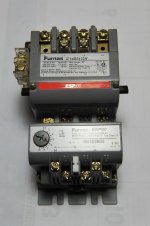Brian Campbell
Plastic
- Joined
- Dec 14, 2021
Hello
I'm building a RPC to convert two legs of a three phase system I have coming in to my property into usable three phase power.
I live in New Zealand which has the same power supply as the UK and Australia. Having two legs of a three phase system is reasonably common on older rural property's in these countries.
There is another post I started about a month ago that thrashes this point to death, for better or worse it is what I have coming in to my property.
That being 230v phase to neutral and 400v between phases.
My two legs are from the same service, phases 120 degrees apart
-----------------------phase-1-------------I DONT HAVE------
-----------------------phase-2-------------I GOT-------------
-----------------------phase-3-------------I GOT-------------
-----------------------Neutral--------------I GOT-------------
I have decided to use four (3-4kw wye wound motors) instead of one large motor.
The reason for this is motor availability and the fact I can have a staggered start on each motor to avoid in rush current issues.
I will be using a siemens 24v dc transformer to power the four motor contactors. I will have a 32a 3 pole cicuit breaker on the main power coming in.
The issue Im having is how to protect the motors individually from overload. Past posts have mentioned typical motor over loads such as Allen Bradley E1 plus wont work as they fault on unbalanced load with a rpc invariably has.
The four motors im using are not identical, they have full load amps on the name plate as follows.
Motor 1 4.8a
motor 2 5.2a
motor 3 7.5a
motor 4 8a
Please find attached a schematic of how I plan to hook up the components I have.
I just would like opinions on were to place overloads and what type to use
Thanks, Brian

I'm building a RPC to convert two legs of a three phase system I have coming in to my property into usable three phase power.
I live in New Zealand which has the same power supply as the UK and Australia. Having two legs of a three phase system is reasonably common on older rural property's in these countries.
There is another post I started about a month ago that thrashes this point to death, for better or worse it is what I have coming in to my property.
That being 230v phase to neutral and 400v between phases.
My two legs are from the same service, phases 120 degrees apart
-----------------------phase-1-------------I DONT HAVE------
-----------------------phase-2-------------I GOT-------------
-----------------------phase-3-------------I GOT-------------
-----------------------Neutral--------------I GOT-------------
I have decided to use four (3-4kw wye wound motors) instead of one large motor.
The reason for this is motor availability and the fact I can have a staggered start on each motor to avoid in rush current issues.
I will be using a siemens 24v dc transformer to power the four motor contactors. I will have a 32a 3 pole cicuit breaker on the main power coming in.
The issue Im having is how to protect the motors individually from overload. Past posts have mentioned typical motor over loads such as Allen Bradley E1 plus wont work as they fault on unbalanced load with a rpc invariably has.
The four motors im using are not identical, they have full load amps on the name plate as follows.
Motor 1 4.8a
motor 2 5.2a
motor 3 7.5a
motor 4 8a
Please find attached a schematic of how I plan to hook up the components I have.
I just would like opinions on were to place overloads and what type to use
Thanks, Brian

Last edited:



